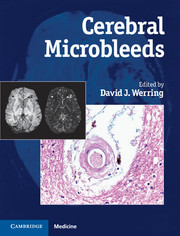Crossref Citations
This Book has been
cited by the following publications. This list is generated based on data provided by Crossref.
Kakar, Puneet
Charidimou, Andreas
and
Werring, David J
2012.
Cerebral microbleeds: A new dilemma in stroke medicine.
JRSM Cardiovascular Disease,
Vol. 1,
Issue. 8,
p.
1.
Charidimou, Andreas
Krishnan, Anant
Werring, David J.
and
Rolf Jäger, H.
2013.
Cerebral microbleeds: a guide to detection and clinical relevance in different disease settings.
Neuroradiology,
Vol. 55,
Issue. 6,
p.
655.
Winkler, Ethan A.
Sengillo, Jesse D.
Sullivan, John S.
Henkel, Jenny S.
Appel, Stanley H.
and
Zlokovic, Berislav V.
2013.
Blood–spinal cord barrier breakdown and pericyte reductions in amyotrophic lateral sclerosis.
Acta Neuropathologica,
Vol. 125,
Issue. 1,
p.
111.
Park, Jae‐Hyun
Seo, Sang Won
Kim, Changsoo
Kim, Geon Ha
Noh, Hyun Jin
Kim, Sung Tae
Kwak, Ki‐Chang
Yoon, Uicheul
Lee, Jong Min
Lee, Jong Weon
Shin, Ji Soo
Kim, Chi Hun
Noh, Young
Cho, Hanna
Kim, Hee Jin
Yoon, Cindy W.
Oh, Seung Jun
Kim, Jae Seung
Choe, Yearn Seong
Lee, Kyung‐Han
Lee, Jae‐Hong
Ewers, Michael
Weiner, Michael W.
Werring, David J.
and
Na, Duk L.
2013.
Pathogenesis of cerebral microbleeds: In vivo imaging of amyloid and subcortical ischemic small vessel disease in 226 individuals with cognitive impairment.
Annals of Neurology,
Vol. 73,
Issue. 5,
p.
584.
Charidimou, Andreas
and
Werring, David J.
2014.
Cerebral Microbleeds as a Predictor of Macrobleeds: What is the Evidence?.
International Journal of Stroke,
Vol. 9,
Issue. 4,
p.
457.
Loehrer, Elizabeth
Vernooij, Meike
and
Ikram, M.
2014.
Cerebral microbleeds: Spatial distribution implications.
Translational Neuroscience,
Vol. 5,
Issue. 2,
Charidimou, Andreas
Wilson, Duncan
Shakeshaft, Clare
Ambler, Gareth
White, Mark
Cohen, Hannah
Yousry, Tarek
Salman, Rustam Al-Shahi
Lip, Gregory
Houlden, Henry
Jäger, Hans R.
Brown, Martin M.
and
Werring, David J.
2015.
The Clinical Relevance of Microbleeds in Stroke study (CROMIS-2): rationale, design, and methods.
International Journal of Stroke,
Vol. 10,
Issue. SA100,
p.
155.
Shams, S.
Martola, J.
Cavallin, L.
Granberg, T.
Shams, M.
Aspelin, P.
Wahlund, L.O.
and
Kristoffersen-Wiberg, M.
2015.
SWI or T2*: Which MRI Sequence to Use in the Detection of Cerebral Microbleeds? The Karolinska Imaging Dementia Study.
American Journal of Neuroradiology,
Vol. 36,
Issue. 6,
p.
1089.
Norrving, Bo
2015.
Evolving Concept of Small Vessel Disease through Advanced Brain Imaging.
Journal of Stroke,
Vol. 17,
Issue. 2,
p.
94.
Shams, S.
Martola, J.
Granberg, T.
Li, X.
Shams, M.
Fereshtehnejad, S.M.
Cavallin, L.
Aspelin, P.
Kristoffersen-Wiberg, M.
and
Wahlund, L.O.
2015.
Cerebral Microbleeds: Different Prevalence, Topography, and Risk Factors Depending on Dementia Diagnosis—The Karolinska Imaging Dementia Study.
American Journal of Neuroradiology,
Vol. 36,
Issue. 4,
p.
661.
Kim, Yeo Jin
Kim, Hee Jin
Park, Jae-Hyun
Kim, Seonwoo
Woo, Sook-Young
Kwak, Ki-Chang
Lee, Jong Min
Jung, Na-Yeon
Kim, Jae Seung
Choe, Yearn Seong
Lee, Kyung-Han
Moon, Seung Hwan
Lee, Jae-Hong
Kim, Yun Joong
Werring, David J.
Na, Duk L.
and
Seo, Sang Won
2016.
Synergistic effects of longitudinal amyloid and vascular changes on lobar microbleeds.
Neurology,
Vol. 87,
Issue. 15,
p.
1575.
Shams, Sara
and
Wahlund, Lars-Olof
2016.
Cerebral microbleeds as a biomarker in Alzheimer's disease? A review in the field.
Biomarkers in Medicine,
Vol. 10,
Issue. 1,
p.
9.
McAleese, Kirsty E.
Alafuzoff, Irina
Charidimou, Andreas
De Reuck, Jacques
Grinberg, Lea T.
Hainsworth, Atticus H.
Hortobagyi, Tibor
Ince, Paul
Jellinger, Kurt
Gao, Jing
Kalaria, Raj N.
Kovacs, Gabor G.
Kövari, Enikö
Love, Seth
Popovic, Mara
Skrobot, Olivia
Taipa, Ricardo
Thal, Dietmar R.
Werring, David
Wharton, Stephen B.
and
Attems, Johannes
2016.
Post-mortem assessment in vascular dementia: advances and aspirations.
BMC Medicine,
Vol. 14,
Issue. 1,
Ungvari, Zoltan
Tarantini, Stefano
Kirkpatrick, Angelia C.
Csiszar, Anna
and
Prodan, Calin I.
2017.
Cerebral microhemorrhages: mechanisms, consequences, and prevention.
American Journal of Physiology-Heart and Circulatory Physiology,
Vol. 312,
Issue. 6,
p.
H1128.
Belliveau, J.-G.
Bauman, G.S.
Tay, K.Y.
Ho, D.
and
Menon, R.S.
2017.
Initial Investigation into Microbleeds and White Matter Signal Changes following Radiotherapy for Low-Grade and Benign Brain Tumors Using Ultra-High-Field MRI Techniques.
American Journal of Neuroradiology,
Vol. 38,
Issue. 12,
p.
2251.
Haller, Sven
Vernooij, Meike W.
Kuijer, Joost P. A.
Larsson, Elna-Marie
Jäger, Hans Rolf
and
Barkhof, Frederik
2018.
Cerebral Microbleeds: Imaging and Clinical Significance.
Radiology,
Vol. 287,
Issue. 1,
p.
11.
Standvoss, Kai
Goerke, Lisa
Crijns, Tanja
van Niedek, Timo
Alfonso Burgos, Natali
Janssen, Démian
van Vugt, Joris
Gerritse, Emma
Mol, Justin
van de Vooren, Dion
Ghafoorian, Mohsen
Manniesing, Rashindra
van den Heuvel, Thomas
Kern, Simon
Mori, Kensaku
and
Petrick, Nicholas
2018.
Cerebral microbleed detection in traumatic brain injury patients using 3D convolutional neural networks.
p.
48.
Ungvari, Zoltan
Yabluchanskiy, Andriy
Tarantini, Stefano
Toth, Peter
Kirkpatrick, Angelia C.
Csiszar, Anna
and
Prodan, Calin I.
2018.
Repeated Valsalva maneuvers promote symptomatic manifestations of cerebral microhemorrhages: implications for the pathogenesis of vascular cognitive impairment in older adults.
GeroScience,
Vol. 40,
Issue. 5-6,
p.
485.
Chou, Kun-Hsien
Wang, Pei-Ning
Peng, Li-Ning
Liu, Li-Kuo
Lee, Wei-Ju
Chen, Liang-Kung
Lin, Ching-Po
and
Chung, Chih-Ping
2019.
Location-Specific Association Between Cerebral Microbleeds and Arterial Pulsatility.
Frontiers in Neurology,
Vol. 10,
Issue. ,
Jung, Young Hee
Jang, Hyemin
Park, Seong Beom
Choe, Yeong Sim
Park, Yuhyun
Kang, Sung Hoon
Lee, Jong Min
Kim, Ji Sun
Kim, Jaeho
Kim, Jun Pyo
Kim, Hee Jin
Na, Duk L.
and
Seo, Sang Won
2020.
Strictly Lobar Microbleeds Reflect Amyloid Angiopathy Regardless of Cerebral and Cerebellar Compartments.
Stroke,
Vol. 51,
Issue. 12,
p.
3600.





